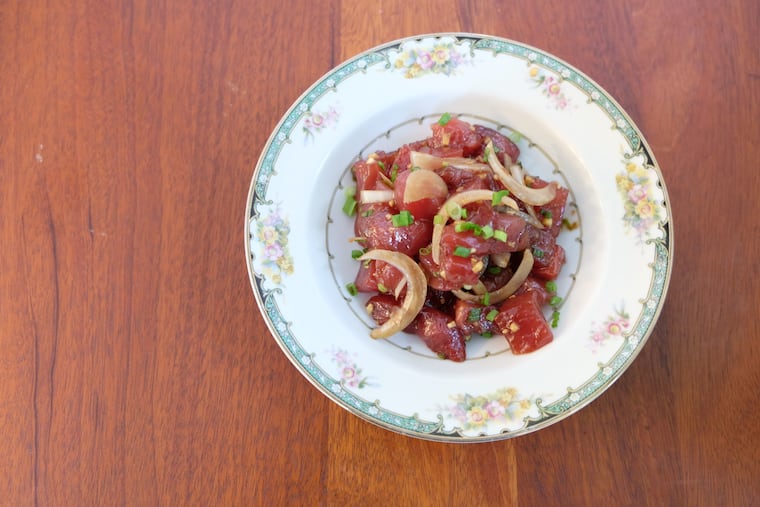Without travel, our recipes make Thanksgiving | Kiki Aranita
Some dishes taste better when someone else makes them for you.

For me, there is no Thanksgiving without shoyu ahi poke.
It’s usually on the table with fried saimin, California rolls, smoky kalua pig, Auntie Dianne’s spinach and water chestnut dip with painstakingly rolled out sesame lavosh, and well, a turkey. I wait in line to eat behind my younger cousins — kids always eat first — and pile little spoonfuls of everything onto a compartmentalized paper plate, making sure to put the shoyu ahi poke next to a requisite scoop of rice. Magic manifests when salt meets fish, and when shoyu and ginger mingle with warm, steamed rice.
The holiday dishes my family enjoys are a common scenario at many multicultural Thanksgiving tables in Hawaii and it is one that I look forward to every year. I tell my mainland friends that we have a Hawaiian-Filipino-Portuguese-Japanese-Okinawan-Chinese-Irish-American Thanksgiving dinner.
But like so many people who have had to cancel trips this year, I will not be spending Thanksgiving with my family in Hawaii.
» READ MORE: How to host a safe outdoor Thanksgiving (and decide if you should)
This year, I’ve been 5,000 miles away as I watched my cousin, the person I’m closest to in the whole world suffer, give birth to a daughter, while her husband’s parents contracted COVID-19. Because of the virus, I watched through my computer screen as my uncle stood over the casket of my aunt who died in August. Despite the many calls and messages exchanged over these months, not knowing when we can all gather together again has made the distance more vast and the six-hour time difference more difficult.
I have lived on the mainland longer than I have in Hawaii. When I return for holidays, my relatives tend to treat me like a visitor, at least for the first few days. My family is enormous. Holidays bring multiple generations and different branches of the family tree under one roof. “Welcome home!” my frail but spirited great-aunts greet me. They tell family friends passing through “This is my niece from the mainland, Lani. Wait, Nikki? Kiki?” They look me up and down, “Which one are you?”
“Jeffrey’s daughter,” I respond over and over, auntie to auntie, scattering kisses on proffered papery cheeks. “Gloria’s granddaughter,” I add, if they continue to narrow their eyes and pinch my arms for verification.
» READ MORE: Craig LaBan's incredible barbecued turkey
My aunts who run the show of Thanksgiving dinner usually assign me easy tasks: Go to the store, order poke, and bring it back. Until last year, I dutifully carried out this errand, fetching poke from Foodland, Tamura’s, or Tanioka’s. I also paused and considered that for eight years I have been making poke professionally, for Poi Dog, the Rittenhouse restaurant and food truck I closed in July (due to the pandemic). I am more than qualified to break down a fish, season it with shoyu and sea salt, and dress it with ginger and seaweed. I can make the poke for Thanksgiving.
But I would prefer not to make the poke.
Ask any professional chef what foods they crave and they often list foods prepared by someone else’s hands. This sentiment is built into the culture of poke in Hawaii. It always tastes better when someone else makes it for you. I would tell first-time customers at Poi Dog, “The cook chooses how to season the fish, tofu, breadfruit, not the consumer.”
I love the poke recipes I’ve created, but I would love them even more if you were to prepare them for me. This year, I am making the mainland feel more like home, taking charge of my own Hawaiian-Filipino-Portuguese-Japanese-Okinawan-Chinese-Irish-American Thanksgiving dinner and preparing the poke to share at the dinner table, with just my boyfriend.
Kiki Aranita’s Shoyu Ahi Poke
This is not so much a recipe, but a template. Feel free to switch out green onions for microgreens, sesame oil for perilla oil or some other fragrant, fresh oil. Add bubu arare, or tiny, microscopic rice crackers for crunch, or ikura for a burst of the sea.
If you are unsure what quality of fish to use, speak with your fishmonger and tell them how you will prepare it. They will advise you on what fish is freshest and can be eaten raw.
Serves 4
Ingredients:
1 pound of fresh ahi (or salmon or firm tofu), skin removed and diced into 1-inch cubes
¼ sweet onion, thinly sliced
1 teaspoon fresh ginger, minced
2 stalks green onion, finely sliced
2-3 tablespoons toasted sesame oil (to taste)
2-3 tablespoons shoyu (to taste)
¼ teaspoon sea salt
1 teaspoon macadamia nuts, chopped
Instructions:
Using a large mixing bowl, mix the ahi (or tofu if using) with all onions, ginger, nuts, and salt until well combined. Add the sesame oil and shoyu in slowly, tasting as you go until you reach the desired level of saltiness.
Serve over warm, steamed short grain rice or wonton chips.